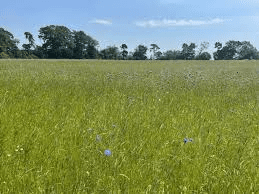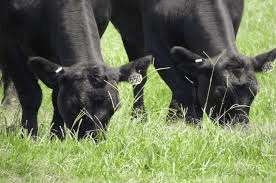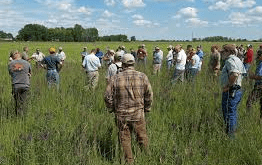Grassland management involves maintaining and improving grassland ecosystems for various purposes, such as supporting wildlife, providing grazing for livestock, preventing soil erosion, and promoting biodiversity.
Grasslands are vast areas covered by grasses and small plants, making them essential ecosystems for both nature and agriculture. Effective grassland management focuses on balancing these needs while ensuring that the land remains healthy and productive over time.
This process includes grazing management, protecting the soil, controlling invasive species, and enhancing biodiversity. Properly managed grasslands provide numerous environmental and economic benefits.
Importance of Grassland Ecosystems
Grasslands play an essential role in supporting wildlife, conserving natural resources, and contributing to agriculture. Here are some reasons why grassland ecosystems are crucial:
1. Support for Livestock and Agriculture: Grasslands serve as vital grazing areas for livestock, such as cows, sheep, and goats, providing a natural source of food for these animals. For example, cattle raised on grassland produce beef, while sheep contribute to wool and lamb production.
2. Biodiversity and Wildlife Habitat: Grasslands are home to a wide variety of plants, animals, insects, and birds, supporting endangered species that rely on these habitats for survival. For instance, the prairie chicken is a bird species that thrives in healthy grassland environments.
3. Prevention of Soil Erosion: Grasslands help protect the soil by stabilizing it with the roots of grass plants, reducing the risk of erosion, which can lead to loss of fertile soil. For example, healthy grasslands prevent valuable topsoil from being washed away during heavy rains.
4. Carbon Sequestration: Grasslands can store carbon in the soil, helping reduce greenhouse gas emissions. This is crucial in mitigating climate change, as deep-rooted grasses absorb carbon dioxide from the atmosphere and store it in their roots and soil.
5. Water Filtration and Retention: The roots of grasses help filter and retain water in the soil, improving water quality by reducing runoff. For example, grasslands can absorb excess rainfall, slowing down water movement and reducing flood risks.
Types of Grasslands

Grasslands can be classified into different types based on their location, climate, and plant species. Below are some of the common types of grasslands:
1. Temperate Grasslands: Found in regions with moderate temperatures and seasonal changes, these grasslands experience hot summers and cold winters, with grasses being the dominant plant type. For example, the prairies of North America are known for their fertile soil and extensive grass cover.
2. Tropical Grasslands (Savannas): These grasslands are found near the equator in regions like Africa, South America, and Australia. They experience warm temperatures throughout the year and distinct wet and dry seasons. For instance, the African savanna supports a variety of wildlife, including elephants and lions.
3. Flooded Grasslands: Found in areas that experience periodic flooding, these grasslands are usually located in tropical or subtropical regions. For example, the Pantanal in South America is a large flooded grassland that is home to diverse wildlife and plant species.
4. Montane Grasslands: Located in mountainous regions where temperatures are cooler, montane grasslands are found above the tree line, where trees cannot grow. For example, alpine meadows are rich in wildflowers and support unique species adapted to high altitudes.
Objectives of Grassland Management
Grassland management aims to achieve several objectives that benefit both the environment and agriculture. These goals focus on preserving the health of the land while maximizing its productivity.
1. Promote Biodiversity: Maintaining a diverse range of plant species creates habitats that support a wide variety of wildlife. For example, a mix of native grasses and flowers attracts different pollinators like bees and butterflies.
2. Ensure Sustainable Grazing: Sustainable grazing is key to managing grasslands used for livestock, allowing the land to support animals without being overgrazed. For instance, rotating grazing areas allows grasses to recover and grow back strong.
3. Prevent Soil Erosion: Reducing soil erosion by maintaining healthy plant cover is an objective of grassland management. Erosion can lead to the loss of fertile topsoil, making the land less productive. For example, grasslands with strong root systems hold soil in place during heavy rains, preventing runoff.
4. Control Invasive Species: Monitoring and controlling invasive species helps protect native plants and animals. For instance, removing invasive weeds can help native grasses thrive and restore natural habitats.
5. Enhance Carbon Sequestration: Well-managed grasslands act as carbon sinks, storing carbon in the soil and helping mitigate climate change. Grassland management practices aim to enhance this function by promoting healthy root systems. For example, planting deep-rooted native grasses can increase carbon storage in the soil.
Read Also Principles and Techniques in Livestock Breeding (Methods of Genetic Improvement)
Grazing Management Techniques

Proper grazing management is essential for maintaining the health and productivity of grasslands. Different techniques can be used to manage grazing and ensure sustainable use of the land.
1. Rotational Grazing: This involves dividing the grassland into smaller paddocks and moving livestock between them regularly. This allows each paddock to rest and recover, preventing overgrazing. For example, rotating cows between different fields helps maintain a healthy pasture.
2. Controlled Stocking Rate: Managing the stocking rate ensures that there are not too many animals grazing at one time. For instance, a farmer may calculate that their pasture can support 10 cows per acre to avoid overgrazing.
3. Deferred Grazing: Allowing grasslands to rest during certain seasons helps plants recover and improve overall health. For example, deferring grazing until after the flowering season allows grasses to seed and replenish.
4. Strip Grazing: In this technique, livestock are confined to narrow strips of pasture using temporary fencing, encouraging even grazing across the area. For example, strip grazing can lead to more efficient use of available forage and healthier pastures.
5. Mixed Species Grazing: Grazing different types of livestock, such as cows and sheep, on the same grassland diversifies the grazing pattern. For example, sheep can graze on shorter grasses that cows might overlook, optimizing pasture use.
Controlling Invasive Species
Invasive species pose a significant threat to grassland ecosystems by competing with native plants, altering the habitat, and reducing biodiversity. Controlling invasive species is a crucial part of grassland management.
1. Early Detection and Monitoring: Regular monitoring helps identify invasive plants or animals before they become widespread. For example, spotting and removing a small patch of an invasive weed early can prevent it from taking over a larger area.
2. Mechanical Control: This involves physically removing invasive plants or animals from the grassland, such as cutting or mowing invasive plants. For instance, using a weed whacker to cut down invasive thistles helps protect native grasses.
3. Chemical Control: This method uses herbicides or pesticides to target invasive species effectively. For example, applying a selective herbicide can kill invasive weeds without harming beneficial native plants.
4. Biological Control: Utilizing natural predators or diseases to control invasive species can be effective. For instance, introducing certain insects to feed on invasive plants helps reduce their population while careful planning is required to ensure that these introduced species do not become invasive themselves.
5. Habitat Restoration: Restoring native habitats can help control invasive species. By replanting native plants and improving soil health, land managers can create conditions that favor native species. For example, planting native grass seeds can help establish a healthy grassland that outcompetes invasive species.
Here’s a comprehensive article on grassland management covering the specified topics:
Soil Health and Fertility Management
Soil health is crucial for the productivity and sustainability of grasslands. Healthy soil supports plant growth and enhances the ecosystem’s overall function. Here are some key aspects of soil health and fertility management:
1. Soil Testing: Regular soil testing helps determine nutrient levels and pH, allowing land managers to understand what amendments are needed. For example, a soil test can show if additional nitrogen or phosphorus is required for optimal grass growth.
2. Organic Matter Addition: Adding organic matter, such as compost or manure, improves soil structure, enhances nutrient availability, and promotes microbial activity. For instance, incorporating compost into the soil increases its moisture retention capacity.
3. Cover Crops: Planting cover crops during the off-season helps prevent soil erosion, suppress weeds, and improve soil fertility. For example, legumes like clover can fix nitrogen in the soil, benefiting subsequent grass growth.
4. Crop Rotation: Rotating grass species with legumes or other crops improves soil health and reduces pest and disease pressures. For example, alternating between grasses and legumes can enhance nutrient cycling.
5. Minimal Soil Disturbance: Reducing tillage preserves soil structure and prevents erosion. Practices such as no-till farming help maintain soil health. For instance, no-till grazing systems protect the soil from compaction and erosion.
Read Also Digestive Anatomy of Ruminants
Grassland Restoration Methods

Restoring degraded grasslands is essential for enhancing biodiversity and productivity. Here are effective methods for grassland restoration:
1. Site Assessment: Conducting a thorough assessment of the site helps identify issues such as soil compaction, invasive species, and nutrient deficiencies. For example, checking soil health and plant diversity informs restoration strategies.
2. Invasive Species Control: Removing invasive plants is crucial for restoration. Mechanical methods like mowing or manual removal can be effective. For instance, cutting back invasive thistles helps promote native grasses.
3. Native Plant Seeding: Planting native grass and wildflower seeds helps restore ecological balance and attract wildlife. For example, sowing local native species can enhance biodiversity and improve habitat quality.
4. Erosion Control Techniques: Implementing measures such as planting grass strips or using erosion blankets can prevent soil loss. For example, establishing grass buffer strips along waterways reduces runoff and soil erosion.
5. Monitoring and Maintenance: Regularly assessing the restored area ensures that it is recovering properly. For instance, checking plant growth and diversity helps identify the need for additional interventions.
Fire Management in Grasslands
Fire plays a natural role in maintaining grassland ecosystems. When managed properly, it can enhance soil health and support biodiversity. Here are some fire management practices:
1. Prescribed Burns: Controlled burns are conducted to remove excess vegetation and promote new growth. For example, a prescribed burn can help rejuvenate grasslands by encouraging the growth of fire-adapted species.
2. Timing and Frequency: Understanding the right timing and frequency of burns is essential. For instance, late spring burns can benefit certain grass species by stimulating growth during the growing season.
3. Safety Precautions: Ensuring that all safety measures are in place is crucial during prescribed burns. This includes having firebreaks and necessary equipment. For example, creating firebreaks with cleared land helps contain the fire.
4. Monitoring Effects: Observing the effects of fire on grassland health helps refine management practices. For instance, tracking plant recovery after a burn can inform future fire management strategies.
5. Community Involvement: Engaging the community in fire management practices fosters understanding and support. For example, conducting workshops on the benefits of prescribed burns encourages local participation.
Water Management for Grasslands
Effective water management is vital for maintaining healthy grasslands. Here are strategies to ensure optimal water use:
1. Water Conservation Techniques: Implementing methods to conserve water helps maintain soil moisture levels. For instance, using mulch can reduce evaporation and improve water retention.
2. Rainwater Harvesting: Collecting rainwater for irrigation can help sustain grasslands during dry periods. For example, installing rain barrels can provide a valuable water source for maintaining grass health.
3. Irrigation Management: Proper irrigation practices ensure that grasses receive adequate water without overwatering. For instance, scheduling irrigation based on weather conditions prevents water waste.
4. Wetland Restoration: Restoring natural wetlands in grassland areas can improve water quality and provide habitats for wildlife. For example, creating small ponds can enhance biodiversity and water availability.
5. Drought Management Plans: Developing strategies to address drought conditions helps protect grassland health. For instance, establishing drought-resistant grass species can enhance resilience during dry spells.
Monitoring and Assessing Grassland Health
Regular monitoring of grassland health is crucial for effective management. Here are key practices for assessing grassland condition:
1. Visual Assessments: Observing plant diversity, vigor, and soil condition provides initial insights into grassland health. For example, a healthy grassland will exhibit a variety of native species.
2. Soil Sampling: Conducting periodic soil tests helps track changes in soil fertility and health over time. For instance, testing for nutrients and pH levels can guide management decisions.
3. Plant Species Inventory: Keeping a record of plant species present helps identify changes in biodiversity. For example, noting the presence of invasive species can trigger necessary management actions.
4. Wildlife Monitoring: Observing wildlife populations indicates the overall health of the ecosystem. For instance, tracking bird populations can reflect the success of restoration efforts.
5. Long-Term Data Collection: Establishing a database of grassland conditions over time aids in identifying trends and informing management strategies. For example, comparing annual plant growth data can indicate improvements or declines in health.
Sustainable Grassland Management Practices
Implementing sustainable practices is essential for the long-term health of grasslands. Here are some strategies to consider:
1. Adaptive Management: Adjusting management practices based on ongoing assessments allows for flexibility and improvement. For example, if a particular grazing strategy isn’t working, land managers can adapt it based on current conditions.
2. Community Involvement: Engaging local communities in grassland management fosters shared responsibility and support. For instance, organizing workshops can educate landowners on sustainable practices.
3. Education and Training: Providing education on best practices helps land managers improve their techniques. For example, offering training sessions on soil health management can enhance land management skills.
4. Collaboration with Experts: Working with agronomists, ecologists, and other experts can improve management outcomes. For instance, consulting with an ecologist can help identify the best native species for restoration.
5. Policy Support: Advocating for policies that support sustainable grassland management is essential. For example, promoting incentives for landowners to implement conservation practices can lead to broader adoption of sustainable methods.
In conclusion, effective grassland management is vital for preserving these ecosystems while providing numerous benefits to agriculture, wildlife, and the environment. By focusing on soil health, restoration methods, fire management, water conservation, monitoring, and sustainable practices, land managers can contribute to the long-term health of grasslands. Understanding these practices allows beginners to engage with grassland management effectively, ensuring that these ecosystems thrive for future generations.
Do you have any questions, suggestions, or contributions? If so, please feel free to use the comment box below to share your thoughts. We also encourage you to kindly share this information with others who might benefit from it. Since we can’t reach everyone at once, we truly appreciate your help in spreading the word. Thank you so much for your support and for sharing!
Read Also How to Make Your Own Organic Pesticides
Frequently Asked Questions
We will update this section soon.
